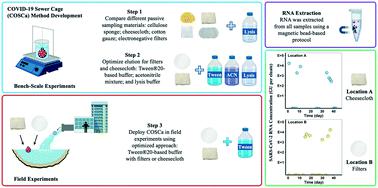当前位置:
X-MOL 学术
›
Environ. Sci.: Water Res. Technol.
›
论文详情
Our official English website, www.x-mol.net, welcomes your
feedback! (Note: you will need to create a separate account there.)
A novel passive sampling approach for SARS-CoV-2 in wastewater in a Canadian province with low prevalence of COVID-19
Environmental Science: Water Research & Technology ( IF 3.5 ) Pub Date : 2021-07-20 , DOI: 10.1039/d1ew00207d E. K. Hayes 1 , C. L. Sweeney 1 , L. E. Anderson 1 , B. Li 1 , G. B. Erjavec 1 , M. T. Gouthro 1 , W. H. Krkosek 2 , A. K. Stoddart 1 , G. A. Gagnon 1
Environmental Science: Water Research & Technology ( IF 3.5 ) Pub Date : 2021-07-20 , DOI: 10.1039/d1ew00207d E. K. Hayes 1 , C. L. Sweeney 1 , L. E. Anderson 1 , B. Li 1 , G. B. Erjavec 1 , M. T. Gouthro 1 , W. H. Krkosek 2 , A. K. Stoddart 1 , G. A. Gagnon 1
Affiliation

|
The overall objective of this work was to develop a simple and effective passive sampling protocol for the detection of SARS-CoV-2 in sewer catchments at targeted institutional-level sampling sites in a region of low COVID-19 prevalence. We developed a new 3D-printed sampling cage and assessed four commercially-available materials (cotton gauze, cotton cheesecloth, cellulose sponges, and electronegative filters) for RNA adsorption in the cage. We determined that cheesecloth and electronegative filters provided an effective approach for collecting and measuring SARS-CoV-2 in wastewater. We also compared the performance of three elution mixtures (a commercially-available lysis buffer, a Tween®20-based buffer, and a 1:1 acetonitrile:water mixture) for detection of heat-inactivated SARS-CoV-2 reference material (HI-SCV-2) spiked into municipal wastewater at 1.0 × 103 genomic units per millilitre (GU mL−1). The highest mean RNA concentrations were achieved using the cheesecloth (7.0 × 104 ± 3.7 × 104 GU per eluate) and electronegative filters (2.3 × 104 ± 2.5 × 104 GU per eluate) in combination with the Tween®20-based buffer with positive detections in all three biological replicates for both material types. We deployed passive samplers at two sewer catchments (locations A and B) to compare the performance of each passive sampler material type in the field. Over 15 sampling events at each site, we demonstrated that both cheesecloth (location A) and electronegative filters (location B) coupled with a Tween®20-based elution technique could be utilized for the reliable detection of SARS-CoV-2. These results have demonstrated a quick and effective passive sampling approach for SARS-CoV-2 detection in targeted locations in wastewater collection systems, which may have long-term applicability as global vaccination programs evolve.
中文翻译:

加拿大 COVID-19 流行率低的省份废水中 SARS-CoV-2 的新型被动采样方法
这项工作的总体目标是开发一种简单有效的被动采样协议,用于在 COVID-19 低流行地区的目标机构级采样点的下水道集水区检测 SARS-CoV-2。我们开发了一种新的 3D 打印采样笼,并评估了四种市售材料(棉纱布、棉粗棉布、纤维素海绵和负电过滤器)用于笼中 RNA 的吸附。我们确定粗棉布和带负电的过滤器为收集和测量废水中的 SARS-CoV-2 提供了一种有效的方法。我们还比较了三种洗脱混合物(市售裂解缓冲液、基于 Tween®20 的缓冲液和 1:1 乙腈)的性能:每毫升3 个基因组单位 (GU mL -1 )。使用粗棉布(每次洗脱液7.0 × 10 4 ± 3.7 × 10 4 GU)和负电过滤器(2.3 × 10 4 ± 2.5 × 10 4GU per ellute) 结合基于 Tween®20 的缓冲液,在两种材料类型的所有三个生物学重复中均得到阳性检测。我们在两个下水道集水区(位置 A 和 B)部署了被动采样器,以比较现场每种被动采样器材料类型的性能。在每个地点进行了超过 15 次采样事件,我们证明粗棉布(位置 A)和带负电的过滤器(位置 B)以及基于 Tween®20 的洗脱技术都可用于可靠检测 SARS-CoV-2。这些结果证明了在废水收集系统的目标位置检测 SARS-CoV-2 的一种快速有效的被动采样方法,随着全球疫苗接种计划的发展,该方法可能具有长期适用性。
更新日期:2021-07-20
中文翻译:

加拿大 COVID-19 流行率低的省份废水中 SARS-CoV-2 的新型被动采样方法
这项工作的总体目标是开发一种简单有效的被动采样协议,用于在 COVID-19 低流行地区的目标机构级采样点的下水道集水区检测 SARS-CoV-2。我们开发了一种新的 3D 打印采样笼,并评估了四种市售材料(棉纱布、棉粗棉布、纤维素海绵和负电过滤器)用于笼中 RNA 的吸附。我们确定粗棉布和带负电的过滤器为收集和测量废水中的 SARS-CoV-2 提供了一种有效的方法。我们还比较了三种洗脱混合物(市售裂解缓冲液、基于 Tween®20 的缓冲液和 1:1 乙腈)的性能:每毫升3 个基因组单位 (GU mL -1 )。使用粗棉布(每次洗脱液7.0 × 10 4 ± 3.7 × 10 4 GU)和负电过滤器(2.3 × 10 4 ± 2.5 × 10 4GU per ellute) 结合基于 Tween®20 的缓冲液,在两种材料类型的所有三个生物学重复中均得到阳性检测。我们在两个下水道集水区(位置 A 和 B)部署了被动采样器,以比较现场每种被动采样器材料类型的性能。在每个地点进行了超过 15 次采样事件,我们证明粗棉布(位置 A)和带负电的过滤器(位置 B)以及基于 Tween®20 的洗脱技术都可用于可靠检测 SARS-CoV-2。这些结果证明了在废水收集系统的目标位置检测 SARS-CoV-2 的一种快速有效的被动采样方法,随着全球疫苗接种计划的发展,该方法可能具有长期适用性。











































 京公网安备 11010802027423号
京公网安备 11010802027423号